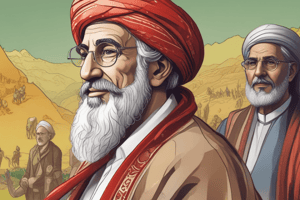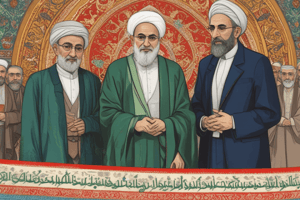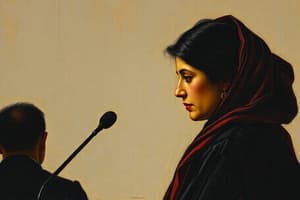Podcast
Questions and Answers
What is the primary role of the Assembly of Experts in Iran's political system?
What is the primary role of the Assembly of Experts in Iran's political system?
- To manage and control Iran's bonyads and economic foundations.
- To select, supervise, and potentially dismiss the Supreme Leader. (correct)
- To serve as a ceremonial advisory council to the Supreme Leader.
- To draft and approve all legislation passed by the Majlis.
What is the main difference between Principalists and Reformists in Iranian politics?
What is the main difference between Principalists and Reformists in Iranian politics?
- Principalists support the current conservative Islamic system, while Reformists seek greater political and social freedoms. (correct)
- Principalists are primarily concerned with foreign policy, while Reformists focus on domestic issues.
- Principalists advocate for closer ties with Western nations, while Reformists prioritize economic self-reliance.
- Principalists believe in a more secular government, while Reformists emphasize the importance of theocracy.
How do economic sanctions typically affect Iran's political landscape?
How do economic sanctions typically affect Iran's political landscape?
- Sanctions have little to no impact on Iran's internal political dynamics.
- Sanctions encourage greater transparency and accountability in Iran's financial institutions.
- Sanctions tend to exacerbate existing economic problems, potentially leading to public discontent and political instability. (correct)
- Sanctions strengthen the power of reformist factions by creating demand for international cooperation.
What does the term 'Equality-with-Difference' signify in the context of Iranian gender policies?
What does the term 'Equality-with-Difference' signify in the context of Iranian gender policies?
How does Iran's unitary system of government impact regional autonomy for ethnic minorities like Kurds, Azeris, and Baluchis?
How does Iran's unitary system of government impact regional autonomy for ethnic minorities like Kurds, Azeris, and Baluchis?
In Iran's political structure, what is the role of the Expediency Council?
In Iran's political structure, what is the role of the Expediency Council?
What was the main cause of the Green Movement protests in 2009?
What was the main cause of the Green Movement protests in 2009?
What is the primary function of the Guardian Council in Iran?
What is the primary function of the Guardian Council in Iran?
How do the powers of the Supreme Leader and the President differ in Iran?
How do the powers of the Supreme Leader and the President differ in Iran?
The 'resource trap' refers to what challenge in Iran?
The 'resource trap' refers to what challenge in Iran?
What is the Revolutionary Guard's (IRGC) primary role in Iran?
What is the Revolutionary Guard's (IRGC) primary role in Iran?
What type of legal system is primarily used in Iran?
What type of legal system is primarily used in Iran?
What is Velayat-e Faqih, and how does it relate to Iran's political system?
What is Velayat-e Faqih, and how does it relate to Iran's political system?
Which of the following factors contributes to the sources of political legitimacy in Iran?
Which of the following factors contributes to the sources of political legitimacy in Iran?
What was the 'White Revolution' initiated by the Shah in the 1960s intended to achieve?
What was the 'White Revolution' initiated by the Shah in the 1960s intended to achieve?
What role do Bonyads play in Iran's economy?
What role do Bonyads play in Iran's economy?
Which historical event significantly shaped Iran’s anti-Western policies?
Which historical event significantly shaped Iran’s anti-Western policies?
How do political parties function in Iran’s political system?
How do political parties function in Iran’s political system?
Which of these presidential successions reflects a shift from a hardliner to a moderate approach?
Which of these presidential successions reflects a shift from a hardliner to a moderate approach?
What distinguishes Iran from many other countries in the Middle East in terms of its religious composition?
What distinguishes Iran from many other countries in the Middle East in terms of its religious composition?
Flashcards
Assembly of Experts
Assembly of Experts
An elected body in Iran responsible for selecting, supervising, and potentially dismissing the Supreme Leader.
Bonyads
Bonyads
Large, state-controlled charitable trusts in Iran that possess significant economic power and are often connected to the clerical elite.
Principalists & Reformists
Principalists & Reformists
Two main political factions in Iran: Principalists (conservatives supporting Islamic rule) and Reformists (advocating for greater freedoms).
Democratically Elected Institutions in Iran
Democratically Elected Institutions in Iran
Signup and view all the flashcards
Economic Sanctions
Economic Sanctions
Signup and view all the flashcards
Equality-with-Difference
Equality-with-Difference
Signup and view all the flashcards
Ethnicity and Religion in Iran
Ethnicity and Religion in Iran
Signup and view all the flashcards
Expediency Council
Expediency Council
Signup and view all the flashcards
Green Movement
Green Movement
Signup and view all the flashcards
Guardian Council
Guardian Council
Signup and view all the flashcards
Human Rights in Iran
Human Rights in Iran
Signup and view all the flashcards
Khatami, Ahmadinejad, Rouhani, Raisi
Khatami, Ahmadinejad, Rouhani, Raisi
Signup and view all the flashcards
Kurds, Azeris, Baluchis
Kurds, Azeris, Baluchis
Signup and view all the flashcards
Legacy of Imperialism, Outside Influence
Legacy of Imperialism, Outside Influence
Signup and view all the flashcards
Majlis
Majlis
Signup and view all the flashcards
Mosaddeq, National Front, and Tudeh
Mosaddeq, National Front, and Tudeh
Signup and view all the flashcards
Political Parties
Political Parties
Signup and view all the flashcards
Powers of Head of Gov’t, Head of State
Powers of Head of Gov’t, Head of State
Signup and view all the flashcards
Resource Trap
Resource Trap
Signup and view all the flashcards
Revolutionary Guard (IRGC)
Revolutionary Guard (IRGC)
Signup and view all the flashcards
Study Notes
- These notes cover the key aspects of Iranian politics, government, and society
Key Institutions and Figures
- Assembly of Experts is an elected body responsible for selecting, supervising, and potentially dismissing the Supreme Leader
- Bonyads are state-controlled, wealthy charitable trusts tied to the clerical elite, dominating Iran's economy
- Principalists support conservative Islamic rule
- Reformists advocate for greater political and social freedoms
- The democratically elected institutions are the Majlis (parliament) and the President
- These are elected by popular vote
- These are limited by clerical oversight
- The Expediency Council mediates disputes between the Guardian Council and Majlis, and advises the Supreme Leader
- The Guardian Council consists of 12 members, vets candidates, oversees elections, and ensures laws comply with Islamic principles
- The Majlis is Iran’s 290-member parliament, which passes laws, but its decisions are subject to Guardian Council approval
- The Supreme Leader holds ultimate power, controlling the military, judiciary, and key government appointments
- Recent Iranian presidents include:
- Khatami (reformist)
- Ahmadinejad (hardliner)
- Rouhani (moderate)
- Raisi (conservative)
Political Ideology and Legitimacy
- Velayat-e Faqih is the principle that clerics should rule, justifying the Supreme Leader’s power
- The sources of political legitimacy include:
- Theocracy based on Velayat-e Faqih (rule by clerics)
- Elections
- Revolutionary ideology
- Iran is a theocracy, a system where religious leaders govern
Social and Economic Factors
- Equality-with-Difference is Iran’s gender policy, granting women legal rights, but within an Islamic framework that limits full equality
- Iran is majority Persian and Shia Muslim
- There are significant Kurdish, Azeri, and Baluchi ethnic minorities
- There are also Sunni Muslim minorities
- The Resource Trap refers to Iran’s oil wealth leading to corruption, state dependency, and economic mismanagement
Key Political Events and Movements
- The White Revolution refers to the Shah’s 1960s modernization reforms
- These included land redistribution and women’s rights
- They angered clerics
- The Revolution of 1979 overthrew the Shah and established an Islamic Republic under Ayatollah Khomeini
- The Green Movement was a 2009 protest movement against alleged election fraud in Ahmadinejad’s re-election
Structure of Government
- The Supreme Leader (head of state) holds ultimate power
- The President (head of government) manages domestic policies but is subordinate to the Supreme Leader
- Iran is a unitary state, meaning power is centralized, rather than divided among regional governments
Challenges and Issues
- Economic Sanctions are restrictions placed on Iran’s economy by the U.S. and others, often due to nuclear ambitions and human rights concerns
- Human Rights in Iran are limited by theocratic rule
- Issues include restrictions on free speech, press, and women's rights
- Legacy of Imperialism from British and U.S. intervention (e.g., 1953 coup against Mosaddeq) shaped Iran’s anti-Western policies
Key Organizations and Laws
- The Revolutionary Guard (IRGC) is a powerful military force loyal to the Supreme Leader
- It controls large parts of Iran’s economy and security
- Sharia Law is the Islamic legal system governing Iran’s laws and judiciary
Historical Context
- Mosaddeq was Iran’s prime minister (1951–53)
- He led the National Front (pro-democracy)
- He was opposed by the Tudeh (communist) party
Studying That Suits You
Use AI to generate personalized quizzes and flashcards to suit your learning preferences.




